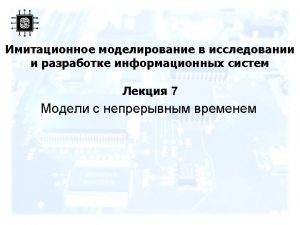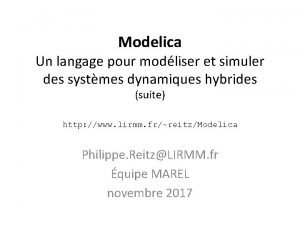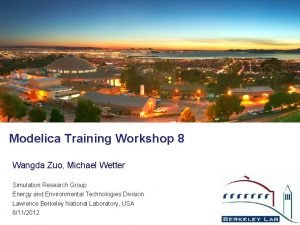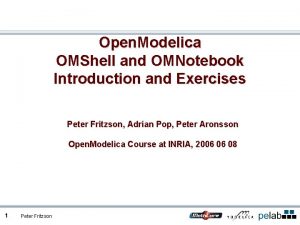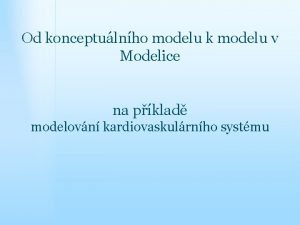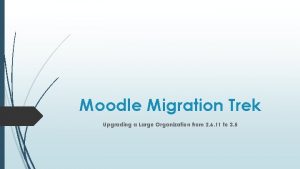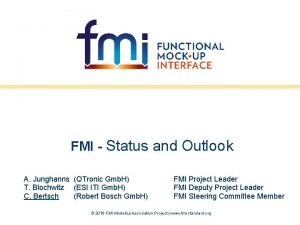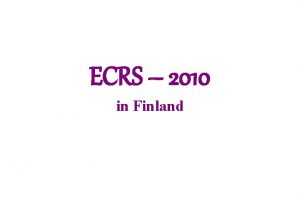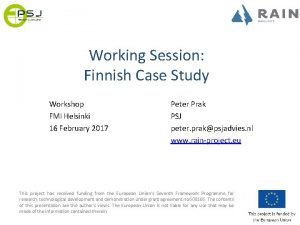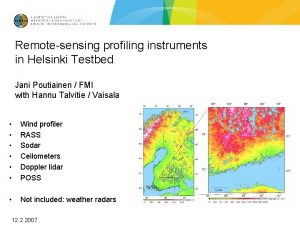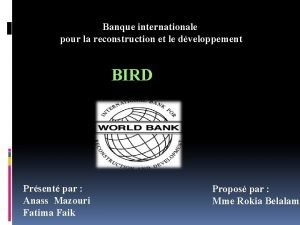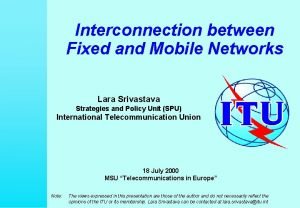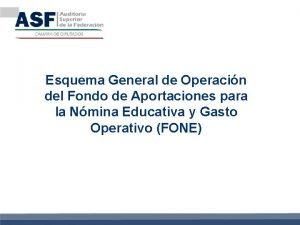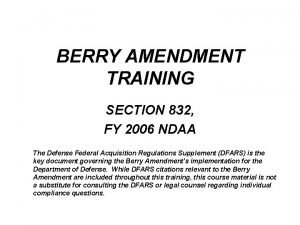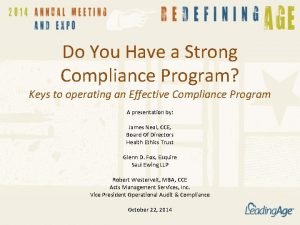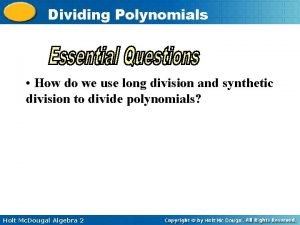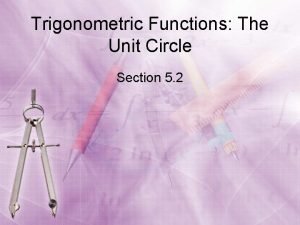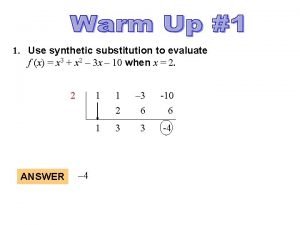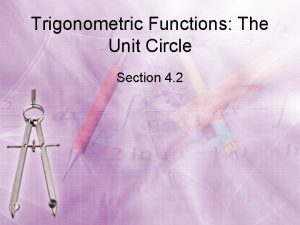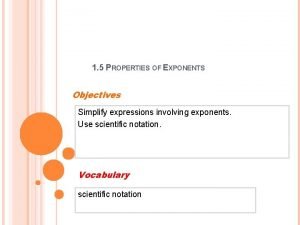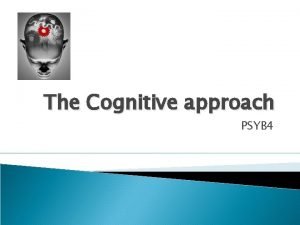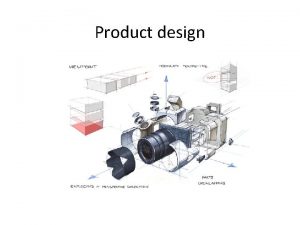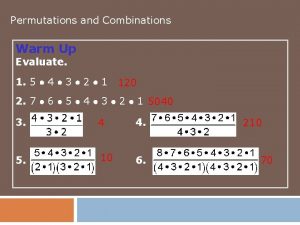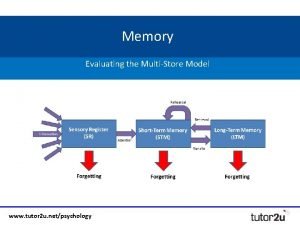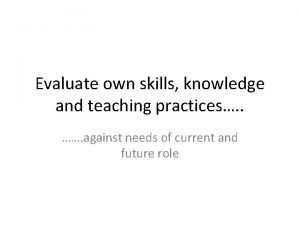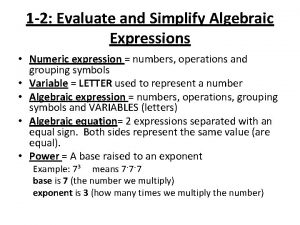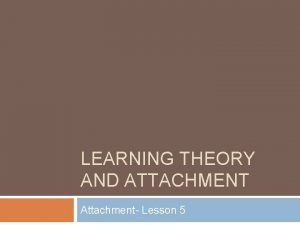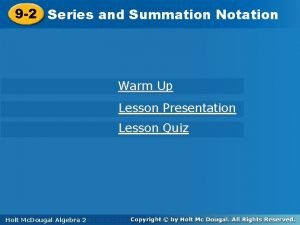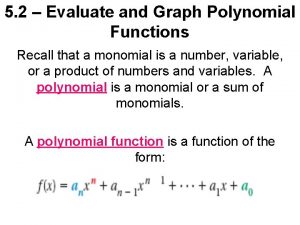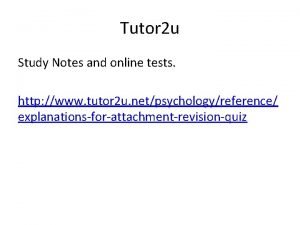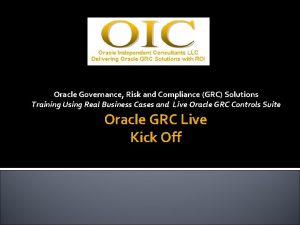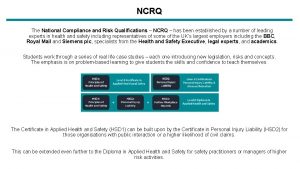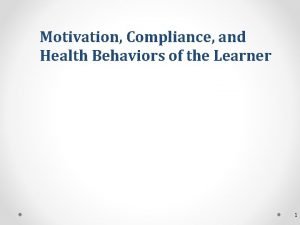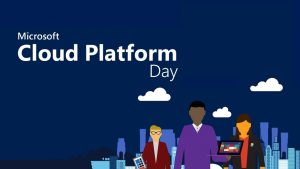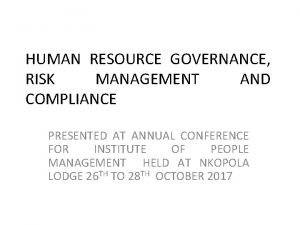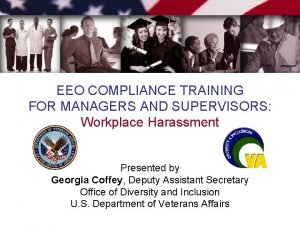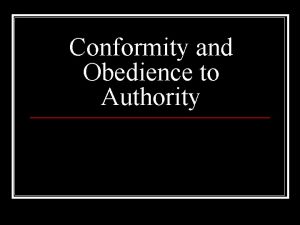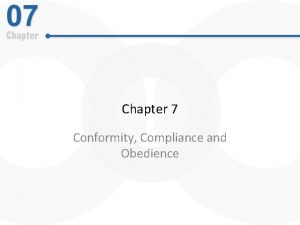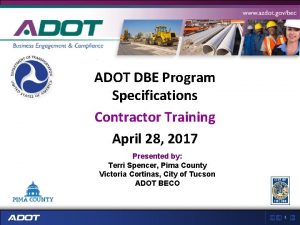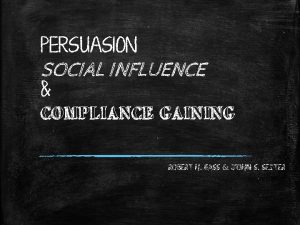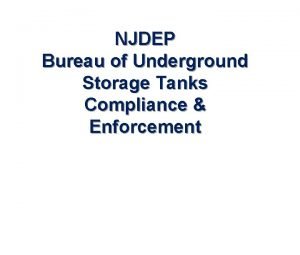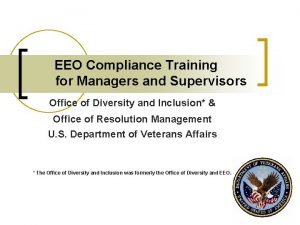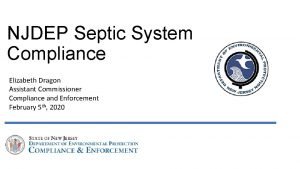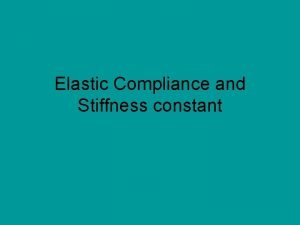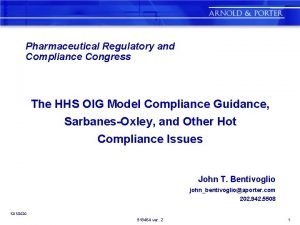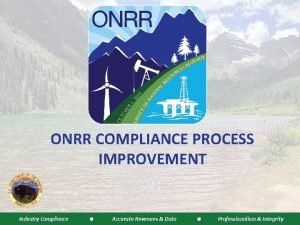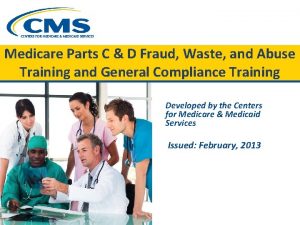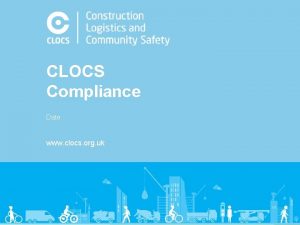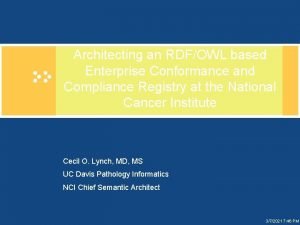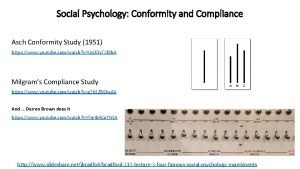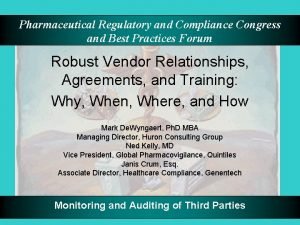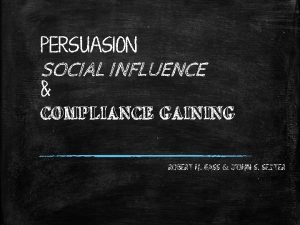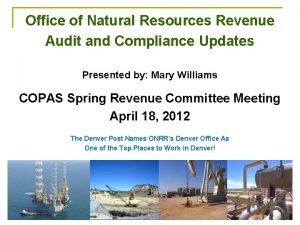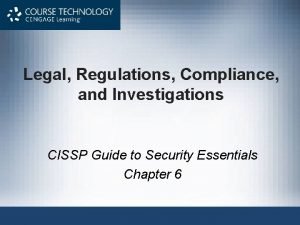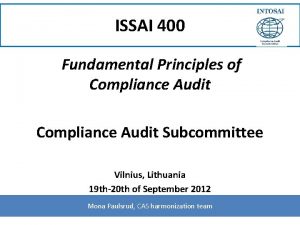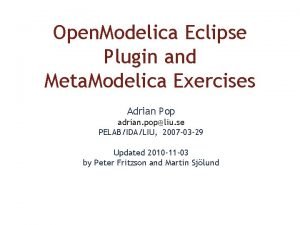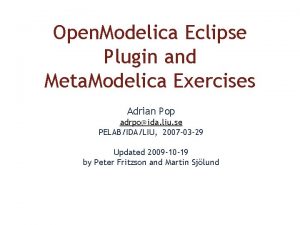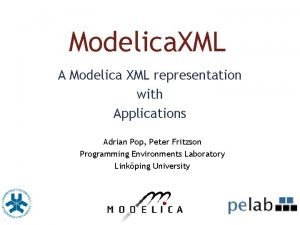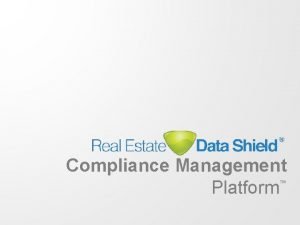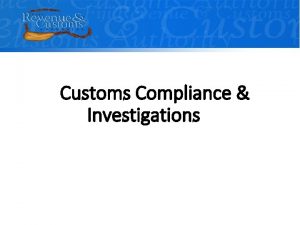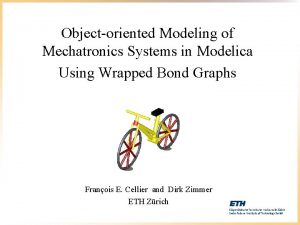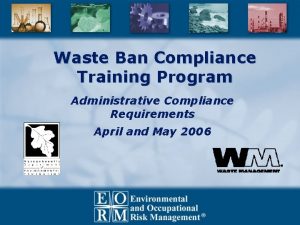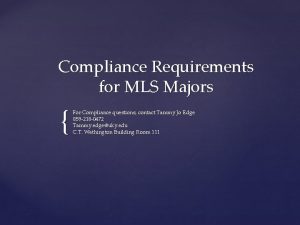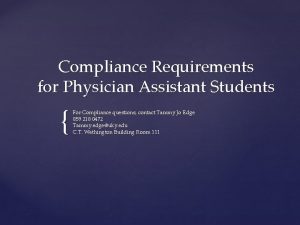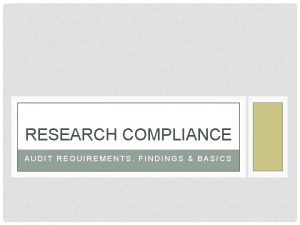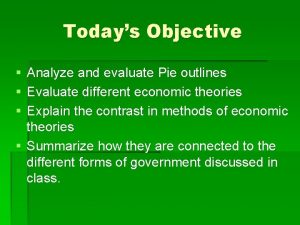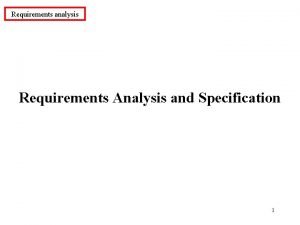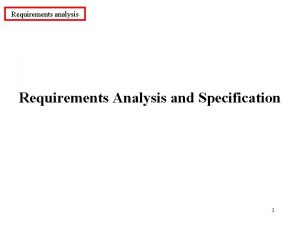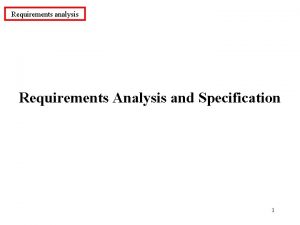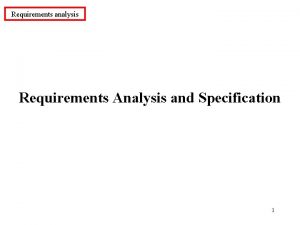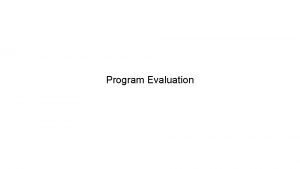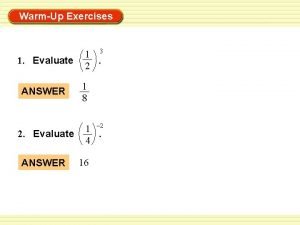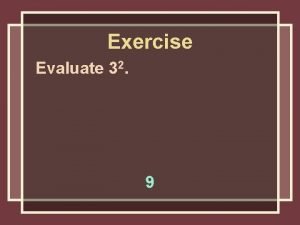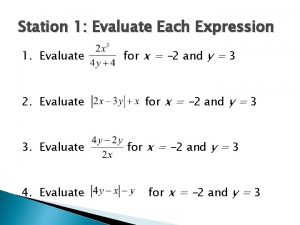USING MODELICA AND FMI TO EVALUATE REQUIREMENTS COMPLIANCE












































![45 CONTROLLER PERFORMANCE Baseline system without grill shutters Coolant Temp [°C] ---- 100. 0 45 CONTROLLER PERFORMANCE Baseline system without grill shutters Coolant Temp [°C] ---- 100. 0](https://slidetodoc.com/presentation_image_h/d7af82686e254e6c5c3dbc67d0482f96/image-45.jpg)

![47 CONTROLLER PERFORMANCE System with simple grill shutters Coolant Temp [°C] Fuel Economy [mpg] 47 CONTROLLER PERFORMANCE System with simple grill shutters Coolant Temp [°C] Fuel Economy [mpg]](https://slidetodoc.com/presentation_image_h/d7af82686e254e6c5c3dbc67d0482f96/image-47.jpg)
![48 CONTROLLER PERFORMANCE System with simple grill shutters Coolant Temp [°C] Fuel Economy [mpg] 48 CONTROLLER PERFORMANCE System with simple grill shutters Coolant Temp [°C] Fuel Economy [mpg]](https://slidetodoc.com/presentation_image_h/d7af82686e254e6c5c3dbc67d0482f96/image-48.jpg)







![56 CONTROLLER PERFORMANCE System with improved grill controller Coolant Temp [°C] Fuel Economy [mpg] 56 CONTROLLER PERFORMANCE System with improved grill controller Coolant Temp [°C] Fuel Economy [mpg]](https://slidetodoc.com/presentation_image_h/d7af82686e254e6c5c3dbc67d0482f96/image-56.jpg)






- Slides: 62

USING MODELICA AND FMI TO EVALUATE REQUIREMENTS COMPLIANCE EARLY IN SYSTEM DESIGN Hubertus Tummescheit, Jesse Gohl, Anh Nguyen Modelon 1

2 AGENDA § § The Functional Mockup Interface: FMI A Real-World Example: Active Grill Shutter Controls Vehicle Thermal Management with Modelica Continuous Validation of System Requirements • Intermediate results from ITEA 3 MODRIO project § Iterative Controller Development Using Rational Rhapsody & Dymola § Conclusions 2020 -12 -03 © Modelon

MODELON Real-World solutions for Systems Engineering Head Office Modelon AB Lund, Sweden Head Office Modelon, Inc. Hartford, CT Engineering Office Modelon, Inc. Ann Arbor, MI Engineering Office Modelon Deutschland Gmb. H Munich, Germany Hamburg, Germany Head Office Modelon KK Tokyo, Japan • Experts in solutions for model-based systems and control design • Global premier provider of FMI and Modelica based solutions for systems engineering • Global customers mostly among Fortune 500 technology companies in Aerospace and Defense, Automotive, Energy and Industrial Equipment • Representative board members for both the FMI and Modelica standards • Over 60 engineers (MSc / Ph. D levels) dedicated to FMI and Modelica © Modelon Inc 3

FUNCTIONAL MOCKUP INTERFACE A brief overview © Modelon

FUNCTIONAL MOCKUP INTERFACE (FMI) • Tool independent standard to support both 2020 -12 -03 5

FMI IN A NUTSHELL • What is FMI? § an application programming interface and its semantics § an xml schema that describes the model structure and capabilities § the structure of a zip file that is used to package the model, its resources and documentation. • 82 tools support in 9 categories. 2020/12/3 © Modelon Supported by ~80 tools: • 0/1 -D ODE Simulators • Multibody Simulators • HIL Simulators /SIL tool chains • Scientific Computation tools • Data analysis tools • Co-simulation Backplanes • Software development tools • Systems engineering tools • SDKs 6

FMI: A BUSINESS MODEL INNOVATION 1. FMI-compliant tools often allow liberally licensed export of models for distribution in the organisation and to partners. 2. Exported FMUs most often don’t require a license from the model authoring tool. 3. Deployment from few simulation specialists to designers, domain specialists, control engineers § One FMU used by many engineers (control design) § One FMU run on many cores (robust design, V&V testing) 2020 -12 -03 7

FMI: A BUSINESS MODEL INNOVATION 1. Separate the model authoring tool from the model execution tool! 2. Free the model unit (FMU) from license restrictions 3. Make the standard widely accepted: https: //fmi-standard. org/tools 4. Increased Collaboration possibilies among typically disparate functional areas 5. Reduced risk & reduction in liability through better virtual verification 2020 -12 -03 8

AUTOMATED REQUIREMENTS VERIFICATION • Systems Engineering centric FMI-based workflow example: automated requirements verification for hardware and software requirements Automate Analysis & Deploy to team! Requirements Formalized requirements Executable model of requirements (e. g. FMU) Physical plant Model of plant Deployable model of plant (FMU) Software spec Software model or prototype Deployable model of software (FMU) Development of a customized workflow to allow rapid iterations of plant & software configuration 2020 -12 -03 Deployable model of environment 9

GRILL SHUTTER CONTROLLER DEVELOPMENT Hardware Model: Dymola/Modelica Controller/Software development platform: IBM Rational Rhapsody • Execution / automation Platform: Dymola • Other options for execution & automation: § Matlab/Simulink § Excel § Python § Any 2020 -12 -03 FMI execution platform 10

REAL WORLD EXAMPLE Fuel economy is won or lost on the system level 2020 -12 -03 © Modelon 11

12 REAL WORLD EXAMPLE § Target: best-in-class fuel economy Grill shutters: • Reduce aerodynamic drag • Improve fuel economy 2020 -12 -03

13 REAL WORLD EXAMPLE § Non-MBSE approach: Develop prototype 2020 -12 -03 Sample Vehicle! Track test prototype

14 REAL WORLD EXAMPLE § MBSE approach: 1. 2. 3. 4. Define requirements Develop model Develop test cases Define requirement monitors Test virtual system instead of physical prototype! Find requirement violation – catch overheating issue early Improve system design to also account for thermal needs 2020 -12 -03

VEHICLE THERMAL MANAGEMENT MODEL Overview

16 INTEGRATED VEHICLE THERMAL MANAGEMENT (VTM) MODEL § Integrated model for fuel economy and vehicle thermal management • Vehicle model with loads and losses • Vehicle heat loads (engine, friction, transmission) • Lumped engine thermal model • Coolant and oil circuits with possible additions of othermal fluid circuits • Drive cycles (speed, grade, wind, etc. ) • Airflow effects • Key vehicle and thermal controls (fan, grill, etc. ) 2020 -12 -03 © Modelon

17 MODELON LIBRARIES § Multi-domain physical model libraries in Modelica § Libraries developed by Modelon domain experts leveraging industrial experience and consulting projects 2020 -12 -03 © Modelon

18 VTM SYSTEM MODEL § § § 2020 -12 -03 © Modelon Thermal Mechanical Electrical Coolant Air

19 THERMAL SYSTEM MODELING Heat from vehicle systems enters coolant fluid Coolant Circuit Coolant 2020 -12 -03 Air Flow

20 DRIVER AND DRIVE CYCLES Drive Cycle Ambient Boundary conditions define test case conditions: • Road grade and surface • Ambient air (temperature, pressure, wind speed, etc. ) • Desired vehicle speed profile (drive cycle) Road 2020 -12 -03 © Modelon

21 TYPICAL DRIVE CYCLE RESULTS

22 TYPICAL DRIVE CYCLE RESULTS (THERMAL) Fan speed is low When vehicle is fast Temperature can only be exceeded for at most X seconds Thermostat opens As engine warms up

REQUIREMENTS VALIDATION Continuous feedback on compliance of requirements

24 REQUIREMENTS VALIDATION § MBSE approach: Requirements Manager Stakeholder Requirements These are usually high level, not always easily testable. Design Requirements These are low level and Formalized testable. When possible Requirements also specified in an open language. Translate standard Specifying the requirements in a to Virtual System Real System way opens the possibility Executable These standard exercise the The requirements manager s to automatically generate the system dynamics. should be able to verify that all Requirements Combining a test case with executable monitors. Test Caseswill When requirements are be tested by Monitors one or. Modify: more monitors allows not met, modifications • Reqs the set of validator The report shows a models. requirements to be verified. The complete set of Complete • System Validator Models can be made to the summary overview of the • Model executable validator models Coverage? system, model or even These are the executable pass/fail results. Notested automatically. can be the requirements. Batch Executable checks to verify the Done Yes 2020 -12 -03 All Pass? Environment Execution requirements are met. Result Report

25 AUTOMATED REQUIREMENTS VALIDATION § MBSE approach: Requirements Manager Stakeholder Requirements Design Requirements Formalized Requirements Real System Virtual System Test Cases Modify: • Reqs • System • Model Done Degree of Automation? Translate to Executable s Requirements Monitors Validator Models No Yes 2020 -12 -03 All Pass? Executable Environment Batch Execution Result Report Complete Coverage?

26 REQUIREMENTS MANAGEMENT Requirements Manager Stakeholder Requirements Design Requirements ü Requirements management tools ü IBM DOORS/DOORS NG ü Requirements quality tools ü Requirements Quality Suite from The Reuse Company ü Requirements traceability ü IBM Requisite Pro, integration with Clear. Quest for testing, . . ü Reqtify (Dassault Systèmes), links Modelica code to req. in DOORS Ø Requirements formalization? Ø Testing of requirements against system model? Ø Continuous Integration tools to repeat tests for every change to the system?

27 EXECUTABLE REQUIREMENTS § MBSE approach: Requirements Manager Stakeholder Requirements Design Requirements Focus on this part Formalized Requirements Real System Done Virtual System Test Cases Modify: • Reqs • System • Model Translate to Executable s Requirements Monitors Validator Models No Yes 2020 -12 -03 All Pass? Executable Environment Batch Execution Result Report Complete Coverage?

28 CURRENT RESEARCH, ITEA 3 (EU) § § ITEA 3 Project: • Model Driven Physical Systems Operation WP: Define requirements formally and check them automatically whenever a Modelica system model is simulated Example „Pumps should not cavitate when they are operating“ (p(t) ≥ pcav if operating) → Define formally + associate conveniently to all pumps + check automatically + report issues automatically State of the art • Not practical (impossible) with available Model Checkers since requirements depend on the numerical solution of Differential-Algebraic Equations (DAE). • Limited tool support for connecting „textual requirements“ with simulation models (e. g. Simulink with Validation & Verification toolbox + IBM DOORS; 3 DExperience with Reqtify + Dymola, . . . ). • Research languages + tools (e. g. Modelica. ML from Airbus Innov. /Li. U). 2020 -12 -03 © Modelon Otter et al: Formal Requirements Modeling for Simulation-Based Verification, Modelica’ 2015

MODRIO VIEW OF REQUIREMENTS VALIDATION 2. Design Architecture (e. g. with Sys. ML) 3. Provide Behavioral Models to evaluate design (Modelica) 4. Associate requirements and architecture with behavioral models 1. Define requirements formally 5. Verify Behavior Natural language: „Pumps should not cavitate when they are operating“ FORM_L (formal language developed by N. Thuy, EDF) required property R 2 = { P in Pumps | during P. In. Operation check not P. Cavitate }; Otter et al: Formal Requirements Modeling for Simulation-Based Verification, Modelica’ 2015

30 PROTOTYPE IMPLEMENTATION § Modelica extension to express requirements (under development) § FORM-L-inspired Modelica library, based on 3 -valued logic: Satisfied, Undecided, Violated § Large Library of pre-defined requirement structures § Executable and formal model of requirements, in Modelica language (x, y) coordinates of input must stay within closed polygon (output: closest distance to polygon + property) 2020 -12 -03 © Modelon

GRILL SHUTTER CONTROLLER Development Cycle

32 SIMPLE GRILL SHUTTER CONTROLLER § Initial bang-bang controller with hysteresis Close the shutters when the vehicle speed exceeds the closing threshold Close Open 2020 -12 -03 © Modelon Open the shutters when the vehicle speed is below the opening threshold

33 SIMPLE GRILL SHUTTER CONTROLLER § Implementation as statechart with two states Entry actions completely open and close grill shutters 2020 -12 -03 © Modelon

34 SIMPLE GRILL SHUTTER CONTROLLER § Statechart transitions Default transition to the open state 2020 -12 -03 © Modelon Transition condition (guard) based on vehicle speed thresholds

35 SIMPLE GRILL SHUTTER CONTROLLER § Generate FMU 2020 -12 -03 © Modelon

36 SIMPLE GRILL SHUTTER CONTROLLER § Import FMU to the execution platform FMU is imported and inserted into a model 2020 -12 -03 © Modelon

THERMAL MANAGEMENT REQUIREMENTS Monitors for requirements compliance checking

38 REQUIREMENTS DOCUMENT 2020 -12 -03

39 TEST CASES Test cases exercise system (or parts of system) under various operating conditions Test cases exercise system Adding cases can (or partstest of system) under improve coverage conditions various operating 2020 -12 -03

40 REQUIREMENTS MONITORS Monitors used to check pass/fail status of requirements from test cases 2020 -12 -03

41 REQUIREMENTS MONITORS • • • Monitors from the new Modelica Requirements library (Otter et al. , 2015) Checks the conditions of the requirement Reports pass, fail, or undecided Constructed from standard blocks from the Requirements library Monitors can be collected in one submodel, and be compiled into an FMU as well M. Otter, N. Thuy, D. Bouskela, L. Buffoni, H. Elmqvist, P. Fritzson, A. Garro, A. Jardin, H. Olsson, M. Payelleville, W. Schamai, E. Thomas, AND A. Tundis. Formal Requirements Modeling for Simulation-Based Verification. Proceedings of the 11 th International Modelica Conference, Paris, France, September 21 -23. , pp. 625 -635 2015. http: //www. ep. liu. se/ecp/118/067/ecp 15118625. pdf 2020 -12 -03

42 Vehicle Velocity Overall pass or fail report 2020 -12 -03 Grill Command Requirements violated (0 of 2): None Requirements untested (0 of 2): None Grill Command [1=open, 0=closed] Monitors added to test cases – in this case a unit test of the simple controller Vehicle Velocity [m/s] REQUIREMENTS MONITORS Requirements satisfied (2 of 2): (check. Req 3. requirement): Grill shutter opened below 15 m/s (check. Req 4. requirement): Grill shutter closed above 18 m/s

CONTROLLER PERFORMANCE Simple Grill Shutter Controller

44 CONTROLLER PERFORMANCE Vehicle runs the US 06 drive cycle 2020 -12 -03 Vehicle Velocity [m/s] Baseline system without grill shutters Null controller holds grill shutters in wide open position
![45 CONTROLLER PERFORMANCE Baseline system without grill shutters Coolant Temp C 100 0 45 CONTROLLER PERFORMANCE Baseline system without grill shutters Coolant Temp [°C] ---- 100. 0](https://slidetodoc.com/presentation_image_h/d7af82686e254e6c5c3dbc67d0482f96/image-45.jpg)
45 CONTROLLER PERFORMANCE Baseline system without grill shutters Coolant Temp [°C] ---- 100. 0 % of US 06_no_shutters requirements are satisfied ------Requirements violated[mpg] (0 of 3): Fuel Economy None Requirements untested (0 of 3): None Engine Speed [RPM] Fan Speed [RPM] Vehicle Speed [m/s] Requirements satisfied (3 of 3): (check. Req 1_1. requirement): Coolant temperature must not exceed 368. 15 K for longer than 20 seconds (check. Req 2_1. requirement): Coolant temperature shall not exceed 371. 15 K (check. Req 3_1. requirement): Grill shutter opened below 15 m/s 2020 -12 -03

46 CONTROLLER PERFORMANCE Replace grill null position controller with statechart based bang-bang control logic as an FMU from Rhapsody Vehicle Velocity [m/s] Repeat the US 06 drive cycle 2020 -12 -03
![47 CONTROLLER PERFORMANCE System with simple grill shutters Coolant Temp C Fuel Economy mpg 47 CONTROLLER PERFORMANCE System with simple grill shutters Coolant Temp [°C] Fuel Economy [mpg]](https://slidetodoc.com/presentation_image_h/d7af82686e254e6c5c3dbc67d0482f96/image-47.jpg)
47 CONTROLLER PERFORMANCE System with simple grill shutters Coolant Temp [°C] Fuel Economy [mpg] ---- 50. 0 of US 06_FMU_simple. GC requirements are satisfied ------Fuel % Economy [mpg] Requirements violated (2 of 4): Temperature exceeds 95°C exceeds for Temperature 98°C (check. Req 1_1. requirement at 86. 3981 s): Coolant temperature must not exceed 368. 15 K for longer than more than 20 seconds (check. Req 2_1. requirement at 111. 523 s): Coolant temperature shall not exceed 371. 15 K Vehicle Speed [m/s] Engine Speed [RPM] Requirements (0 of to 4): In untested addition None failed Failed thermal requirements, Fan Speed [RPM] Requirements satisfied (2 of 4): fuel economy actually (check. Req 3_1. requirement): Grill shutter opened below 15 m/s decreased!Grill shutter closed above 18 m/s (check. Req 4_1. requirement): 2020 -12 -03
![48 CONTROLLER PERFORMANCE System with simple grill shutters Coolant Temp C Fuel Economy mpg 48 CONTROLLER PERFORMANCE System with simple grill shutters Coolant Temp [°C] Fuel Economy [mpg]](https://slidetodoc.com/presentation_image_h/d7af82686e254e6c5c3dbc67d0482f96/image-48.jpg)
48 CONTROLLER PERFORMANCE System with simple grill shutters Coolant Temp [°C] Fuel Economy [mpg] Engine Speed [RPM] Vehicle Speed [m/s] Closed grill shutters reduces air flow through Fan Speed [RPM] the stack. Compensated for by increased the fan speed, draws more electrical power from the alternator… and ultimately the engine. 2020 -12 -03

IMPROVED CONTROLLER DESIGN

50 IMPROVED CONTROLLER DESIGN § Improved controller state chart Additional inputs to account for system temperatures System with simple grill shutters 2020 -12 -03

51 IMPROVED CONTROLLER DESIGN § Improved controller statechart Additional attributes to tune improved logic System with simple grill shutters 2020 -12 -03

52 IMPROVED CONTROLLER DESIGN § Improved controller statechart Additional states to organize improved logic System with simple grill shutters 2020 -12 -03

53 IMPROVED CONTROLLER DESIGN § Improved controller statechart Controller includes a PID controller • Continuously modulate the grill position between open and closed • Measured signal is weighted average of stack fluid temperatures Proportional Derivative System with simple grill shutters Integral 2020 -12 -03

CONTROLLER PERFORMANCE Improved Grill Shutter Controller

55 CONTROLLER PERFORMANCE Repeat the US 06 drive cycle 2020 -12 -03 Vehicle Velocity [m/s] Replace the simple bang-bang control logic with the improved controller as an FMU from Rhapsody
![56 CONTROLLER PERFORMANCE System with improved grill controller Coolant Temp C Fuel Economy mpg 56 CONTROLLER PERFORMANCE System with improved grill controller Coolant Temp [°C] Fuel Economy [mpg]](https://slidetodoc.com/presentation_image_h/d7af82686e254e6c5c3dbc67d0482f96/image-56.jpg)
56 CONTROLLER PERFORMANCE System with improved grill controller Coolant Temp [°C] Fuel Economy [mpg] ---- 100. 0 % of US 06_FMU_advanced. GC requirements are satisfied ------Requirements violated (0 of 3): None Fuel Economy [mpg] Requirements untested (0 of 3): None Engine Speed [RPM] Requirements now pass. Vehicle Speed [m/s] Requirements satisfied (3 of 3): Fuel economy improved, (check. Req 1_1. requirement): Coolant temperature must not exceed 368. 15 K for longer than 20 seconds Fan Speed also over. Coolant baseline (check. Req 2_1. requirement): temperature shall [RPM] not exceed 371. 15 K (check. Req 3_1. requirement): Grill shutter opened below 15 m/s 2020 -12 -03

SUMMARY & CONCLUSIONS • FMI simplifies tool connectivity and allows more efficient work flows & processes • FMI enables true MBSE, with executable models • Requirements monitors allow to check requirements compliance continuously during development • Process automation is key to integrate the requirements validation with MBD. 2012 -05 -24 © Modelon Confidential 57

FUTURE WORK • Further integration with IBM tool suite for fully automated traceability • Complete automation of requirements validation process • … much more progress on tools is needed to have a coherent work flow from § stakeholder requirements to § formal requirements and finally § fully automated requirements validation. 2012 -05 -24 © Modelon Confidential 58

ALL CONNECTED! 2013 -06 -11 © Modelon 59

FOR MORE INFORMATION: info@modelon. com, +1 (860) 987 8900

FMI ADVANTAGE • Same model – different applications 2013 -09 -02 © Modelon

PARTICIPANTS 2012 -05 -24 © Modelon Confidential 62
 Modelica book
Modelica book Langage modelica
Langage modelica Modelica training
Modelica training Omnotebook
Omnotebook Modelica
Modelica Moodle fmi
Moodle fmi Modelon fmi
Modelon fmi Fmi status
Fmi status Fmi objetivos
Fmi objetivos Fmi turku
Fmi turku Fmi helsinki
Fmi helsinki Helsinki testbed
Helsinki testbed Fmi bird
Fmi bird Fmi msu
Fmi msu Fmi portal fone
Fmi portal fone Berry compliance requirements
Berry compliance requirements Ppaca compliance program requirements
Ppaca compliance program requirements When to use long division or synthetic
When to use long division or synthetic Evaluate the trig function using its period as an aid
Evaluate the trig function using its period as an aid Synthetic substitution examples
Synthetic substitution examples Unit circle explained
Unit circle explained Simplifying properties of exponents
Simplifying properties of exponents Cognitive psychology essay
Cognitive psychology essay Evaluate and revise in assure model
Evaluate and revise in assure model Productdesigners do not conceptualize and evaluate ideas
Productdesigners do not conceptualize and evaluate ideas Formula for permutation and combination
Formula for permutation and combination Multi-store model of memory
Multi-store model of memory What is media information
What is media information Evaluate own knowledge and performance
Evaluate own knowledge and performance Evaluate and simplify
Evaluate and simplify Outline and evaluate the learning theory of attachment
Outline and evaluate the learning theory of attachment Zam is laying out patio stones in a triangular pattern
Zam is laying out patio stones in a triangular pattern Evaluate and graph polynomial functions
Evaluate and graph polynomial functions Outline and evaluate bowlby's monotropic theory 8 marks
Outline and evaluate bowlby's monotropic theory 8 marks Using system using system.collections.generic
Using system using system.collections.generic Accumulator ac
Accumulator ac Oracle grc
Oracle grc Ncrq national compliance and risk qualifications
Ncrq national compliance and risk qualifications Motivational axioms
Motivational axioms Contractor compliance and monitoring inc
Contractor compliance and monitoring inc Azure security privacy compliance and trust
Azure security privacy compliance and trust Hr governance risk and compliance
Hr governance risk and compliance Eeo training for managers
Eeo training for managers Conformity examples
Conformity examples Conformity compliance and obedience
Conformity compliance and obedience Adot - business engagement and compliance (beco)
Adot - business engagement and compliance (beco) Elastic recoil and compliance
Elastic recoil and compliance Gass and seiter model
Gass and seiter model Njdep ust guidance
Njdep ust guidance Eeo compliance training for managers and supervisors
Eeo compliance training for managers and supervisors What is dragon assistant 3
What is dragon assistant 3 Elastic strain and plastic strain
Elastic strain and plastic strain Oig pharma compliance guidance
Oig pharma compliance guidance Onrr reporting and compliance
Onrr reporting and compliance Medicare parts c and d general compliance training answers
Medicare parts c and d general compliance training answers Fors and clocs compliance
Fors and clocs compliance Conformance and compliance
Conformance and compliance Conformity and compliance
Conformity and compliance Pharmaceutical regulatory and compliance congress
Pharmaceutical regulatory and compliance congress Persuasion social influence and compliance gaining
Persuasion social influence and compliance gaining Onrr reporting and compliance
Onrr reporting and compliance Legal regulations compliance and investigation
Legal regulations compliance and investigation Issai 4200
Issai 4200
